How to Figure Out Reading Glasses From Prescription
How to Read My Prescription
How to Read
My Prescription

When you lot leave your eye doctor's office and look at your prescription, it may seem like an unrecognizable series of numbers and abbreviations. It makes ordering prescription glasses online challenging and overwhelming. Let's take a moment to decipher and understand what'south on your prescription. Allow'southward go started.

Take NV/DV/SV on your prescription?
NV stands for near vision for reading utilise or calculator utilize.
DV stands for altitude vision for constant wear or daily utilise. Doctors ordinarily use this to distinguish different usage.
SV means single vision. Doctors use this to tell you that you need unmarried vision lens instead of bifocal or progressive lens.
How To Read Eyeglasses Prescriptions?
Then you need to know OD and OS. OD means 'correct middle' and OS ways 'left eye'.


| SPH | SPH stands for sphere or spherical power. This indicates the corporeality of lens forcefulness. There volition exist a plus sign for farsighted and negative sign for nearsighted - followed by a number. The larger the number, the stronger the prescription yous needed to correct your vision. |
| CYL and Axis | If you accept astigmatism, CYL and Centrality volition be full in your prescription. Astigmatism is where the middle is non completely spherical only shaped more like a football. CYL or cylinder is the degree of how flat your eye is. The higher the number, the more astigmatism yous have. The AXIS represents the orientation or bending of your astigmatism. From i to 180 degrees. |
| ADD | Add together is an additional strength for your lens for reading or upclose work. If you demand reading, intermediate, bifocal or multifocal, or progressive lenses, this should be listed in your prescription. |
| PD | PD: This number indicates the distance from the heart of ane pupil to the centre of the other, and is an important number for lens customization. If your prescription doesn't take your PD on it, don't worry, we have a tutorial that teaches you how to measure your PD yourself. |
| Prism | Prism: This is the amount of prismatic power, measured in prism diopters ("p.d." or a superscript triangle when written freehand), prescribed to compensate for heart alignment problems. |
Other questions
Q: What is a PD?
PD stands for Pupillary Distance, which is the measurement from the middle of one pupil to the middle of the other. Your PD is an of import factor and tells yous where yous await through the lens of your spectacles and should exist as accurate as possible. For people with potent prescription, this is especially important. Y'all can normally find your PD on your prescription. Generally speaking, the PD numbers for adults stays the same. The average PD range for adults is 57-72 mm and for kids is virtually 43-58 mm.
Q: I have dual PD, how can I enter it?
A dual PD would exist provided with 2 numbers and would appear and is the measurement of each educatee center to the center of the bridge of the nose, in millimeters. Dual PD appears in the following format: "31.5/31.5". When placing the order, please click "Ii PD numbers" to enter your dual PD.
Q: I take PLANO /PL under SPH on my prescription
If in that location is "Plano" or "PL" in the SPH section of an Rx, information technology means no nearsighted or farsighted correction is needed. But go out information technology as a nix or Plano when entering the prescription on the club class on our website.
Q: I take SPHERE/SPH /S/DS under CYL on my prescription
If the optometrist wrote "DS" or "Sph" or "Spherical" in the Cylinder space, it indicates no correction and should be entered as 0 on the order form. This means that the eyeball is spherical and has no oblongedness, and consequently has no Cylinder or Axis values.
Q: I take Residue/BAL on my prescription
Balance indicates that the centre for which the designation is made, is not sighted, and that the same numbers should exist entered in both optics, in order to have the lenses matched in appearance and weight.
Q: I have PAL (progressive addition lens )on my prescription.
PAL,the Progressive Adjusted Lens. Because of the limited reading area of a progressive lens design, the Add portion of a prescription is increased by a quarter of a diopter (typically) to compensate by increasing the size of the paradigm. It does not change the size of that portion of the lens. If you have two ADD values in your prescription (ADD +two.00 and ADD +2.25 PAL), the Add value +2.00 should be used for both eyes of bifocal while ADD value +ii.25 should exist used for both optics of progressive.
Q: Tin can I utilise my contact lens prescription when ordering eyeglasses?
Unfortunately, contact lens and eyeglass prescriptions are different. The uncomplicated reason is because contact lenses sit straight on your optics, while eyeglasses are held in front of your eyes. Though the prescriptions may appear similar, they will differ in force and are not interchangeable. We cannot — and, for your safety, would not — use your contact lens prescription to make your spectacles. And nosotros would advise yous to contact your center doctor to get your eyeglasses prescription.
I accept a prescription, how to read it for different uses

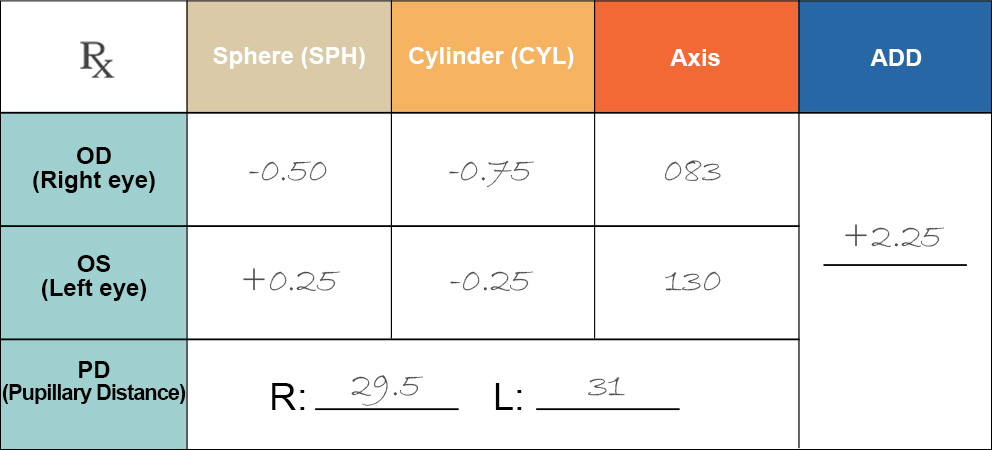
For progressive or bifocal glasses, the prescription can exist read as:

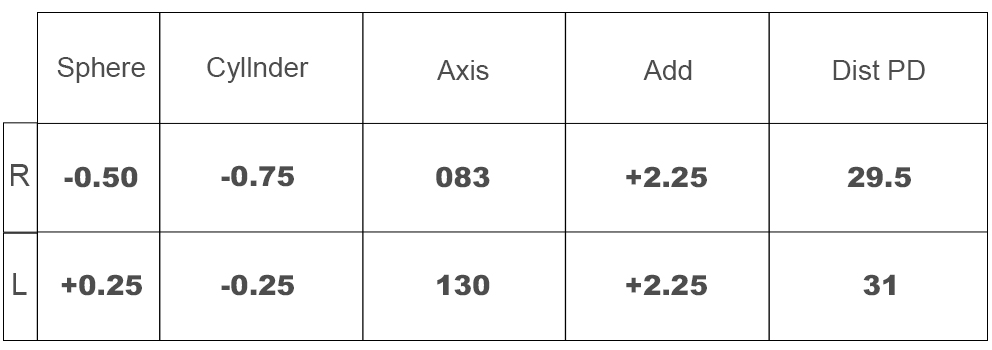
For single vision distance use, the prescription tin be read as:

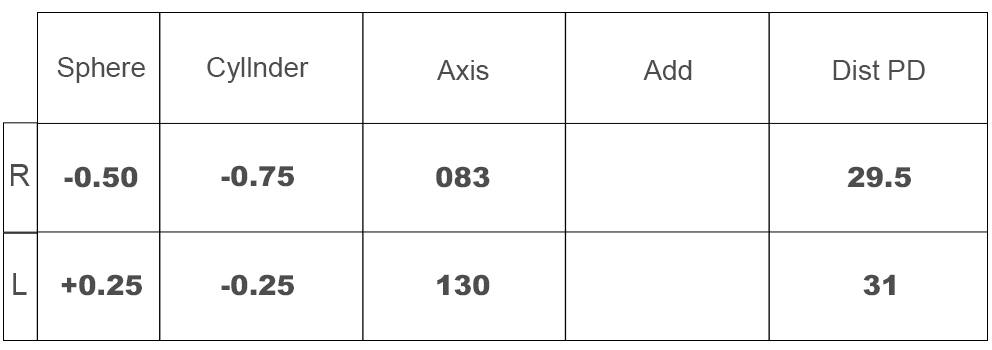
To convert a multi-focal prescription with ADD values for single vision distance utilize, just remove the ADD values. The correction for the astigmatism will non change, so the cylinder and axis volition remain the same, regardless of the change in focal distance. Use the original distance PD listed in the prescription.
For unmarried vision calculator use, the prescription can be read as:

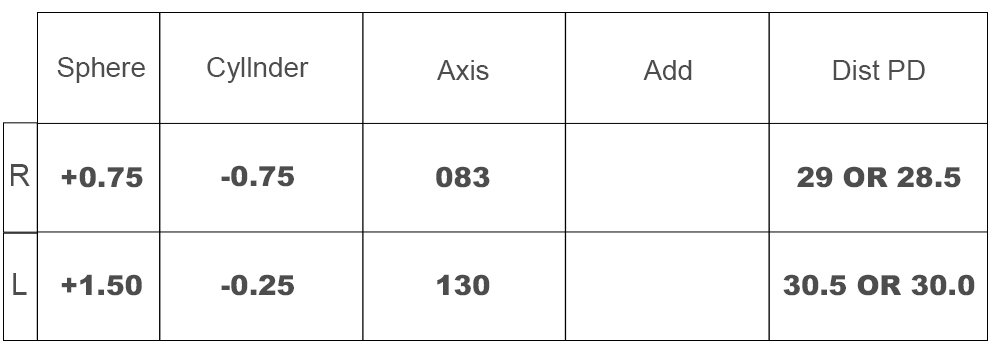
To convert a multi-focal prescription for unmarried vision computer use, simply combine one-half of the Add number and the Spherical number (If the Add together cannot be split evenly, such as ADD +2.25, both +1.25 and +1.00 can be used to catechumen the prescription). For example, if the Add were +two.25 and the OD-Sph was -0.50, the new OD-Sph for computer spectacles would be +0.75; if the Sph were +0.25, the new Sph would be +1.50. Consequently, the Add will then become nix, the default. The correction for the astigmatism will not change, and then the cylinder and axis will remain the aforementioned, regardless of the modify in focal distance. Narrow the PD past 1-2 mm. If the PD of your basic prescription is 29.five/31.0, the PD for computer glasses would be 29.0/thirty.5 or 28.five/30.0
For single vision reading apply, the prescription tin can be read as:

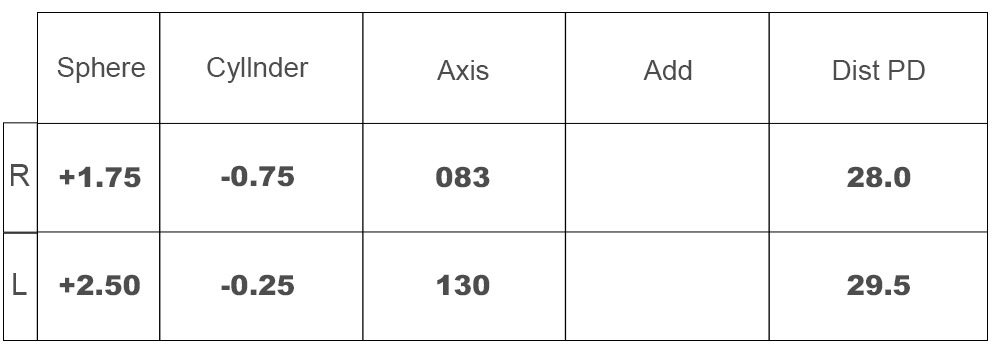
To convert a multi-focal prescription for single vision reading glasses, only combine the Add together number and the Spherical number. For example, if the Add were +two.25 and the OD-Sph was -0.50, the new OD-Sph for reading glasses would be +1.75; if the Sph were +0.25, the new Sph would be +2.50. Consequently, the Add will then become zero, the default. The correction for the astigmatism will not modify, then the cylinder and axis will remain the aforementioned, regardless of the change in focal altitude. Narrow the PD by 3mm. If the PD of your basic prescription is 29.5/31.0, the reading PD would be 28.0/29.v.
That'south it most prescriptions.
For more information, bank check our help center. We promise this was informative and helpful!
Source: https://www.glassesshop.com/doc/how-do-i-read-my-prescription
0 Response to "How to Figure Out Reading Glasses From Prescription"
Postar um comentário